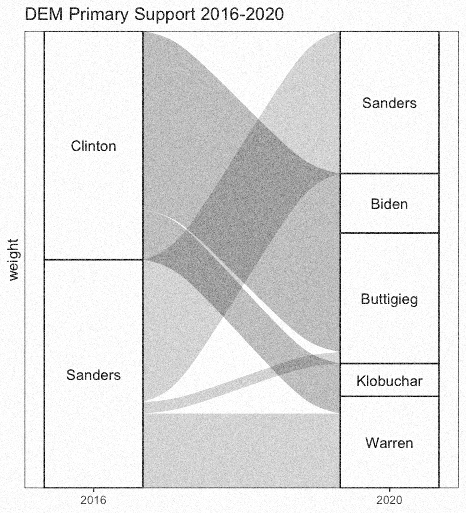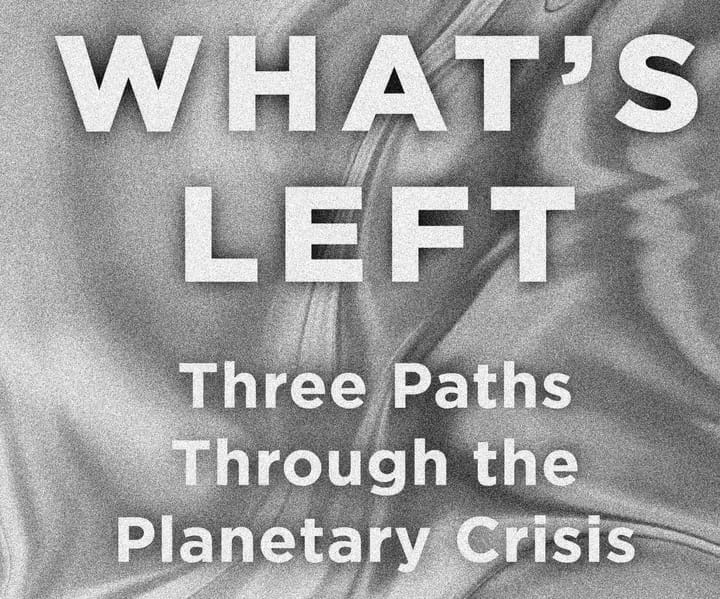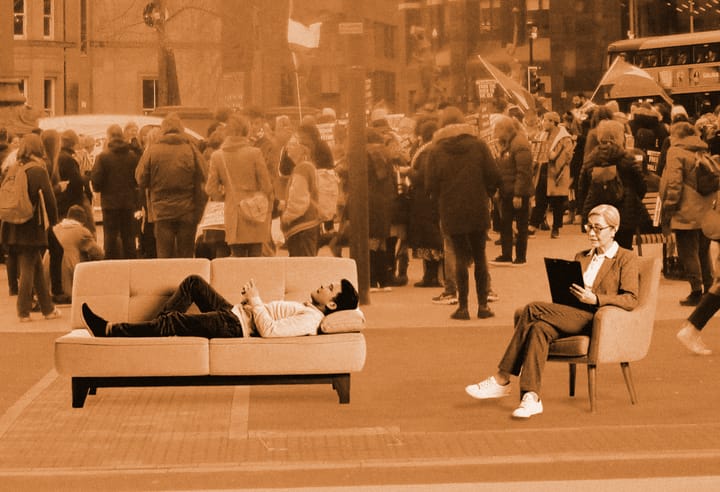Unpacking the Left's Cultural Baggage
Why the Left’s embrace of cultural liberalism hurts our electoral ambitions.

This article was originally published in The Bellows on May 11, 2020. No substantive changes were made in this republication. Admittedly, the swift ascendance since the article’s original publication of what Cedric Johnson has called “militant liberalism” makes some of the conclusions here seem rather distant. Despite its unpopularity, cultural liberalism bears powerful proponents, including the liberal foundation world, nonprofit sector, and academia, not to mention the Democratic Party apparatchiks. What is called “social liberalism” in this article once served their purposes well: it provided a legitimating ideology for neoliberalism. It’s possible that they are now willing to abandon it entirely for the illiberal compulsions of cultural liberalism, which, when militantly enforced and allied to a cause as straightforwardly just as the fight against police brutality in the wake of the horrific murder of George Floyd, compensates for its lack of popularity with its disciplinary function. In these conditions, Johnson intuits, it offers “the perfect valence to mount the center-right Democratic renewal.”
To slightly repurpose the words of Anton Jäger, “it might take a while before history starts again.”
The Left today bears a curious relationship to liberalism.
On the one hand, we’re keen to critique certain aspects of liberal nonsense, like “lean-in” feminism or the absurdities of The New York Times. But we’ve also strangely accepted the contemporary culture of liberalism as bearing moral authority, as if it somehow floats free from liberals’ general political interests.
This “cultural liberalism,” which demands “intersectional” thinking and deferential behavior in accordance with reified social identities, dominates progressive activist circles. The ostensible purpose of its imperatives is to create subcultural pockets that fulfill liberal social ideals as a way of prefiguring their political reality.
There’s a contradictory logic at play here: social liberalism is about tolerance, about not impinging on the freedom of others; but modern cultural liberalism functions as the opposite, compelling people to act in accordance with one’s own expectations.
The Left has always affirmed liberalism’s commitment to freedom from discrimination and protected rights for all, while skewering liberals for failing to back the economic program necessary to realize those ideals as positive freedoms. It would thus be possible for us to fight against racism, sexism, and any form of discrimination while also spurning an obsession with identity, privilege-checking, and the increasingly demanding expectations around “correct” speech and action as offputting manifestations of a decadent liberalism. But instead we’ve seen a program of universal demands wrapped in the unappealing packaging of liberal rhetoric and “values.”
A Deep Unpopularity
There are theoretical problems with “intersectionality” and the ascriptive hierarchies upon which it relies, but my concern here is practical, not academic. If we’re to accept the polls, the adoption of cultural liberalism has devastating political consequences.
The broad majority of people in America are on board with the Left’s economic policy (Medicare for All, tuition-free public college, workplace democracy, a living wage) and support liberal social ideals (LGBTQ+ rights, reproductive freedom). Most people really like the substance of what the Left champions, and that should be a very encouraging sign.
But what they really don’t like—and I mean really don’t like—are the many forms of cultural policing rooted in identitarian thinking.
This is because they take intersectional moralizing to reflect “not so much genuine concern for social justice as the preening display of cultural superiority.” The idea behind intersectionality might be noble enough, but a compulsive focus on identity categories often gives the impression that one cares more for demonstrating a mastery of human taxonomy than for actual human beings.
People also generally despise ever-evolving constraints on thought and discourse, and indeed, it’s evidence of the very success of social liberalism that they do so. Even in the blinkered terms of liberal ideology, one has to wonder whether cultural liberalism is a force of progress or regress.
In sum, the Left rightly affirms liberal social aims, but somehow we’ve made the mistake—perhaps from a lack of confidence in the socialist project, middle-class anxieties, or just not having the energy to deal with liberals calling us names—of thinking we need to adopt cultural liberalism to do so. We don’t need to—there’s nothing about liberal cultural modes that prepares one to fight for liberal social aims, which we know by the fact that liberals abide by them—and we shouldn’t, given the wild unpopularity across demographic groups of liberal culture.
An Obstacle to our Electoral Ambitions
Cultural liberalism hurts the Left’s electoral ambitions in at least two ways, both of which were on display in the 2020 presidential primary. First, it is effortlessly wielded by liberal politicians to siphon away our support, and second, its deep unpopularity limits the appeal of our political program.
The first way has been covered well elsewhere, so I won’t belabor the point. But it’s worth reproducing a graphic from The Washington Post mentioned in Nathan Robinson’s recent Bernie post-mortem, which visually represents the fracturing of the 2016 Sanders coalition in the Iowa caucuses.
“Progressives” hold this up as an unfortunate consequence of the good luck to have had two “progressives” in the race, but the Left should not be fooled. Furthermore, we should expect this essential dynamic—the siphoning of support for left candidates by identitarian “progressives”—to play out in future electoral cycles and should adjust our strategy accordingly.
By always presenting our program in the garb of cultural liberalism, we allow liberal politicians to dress themselves up as Leftists and divide our base of support. We can lament this fact all we want, but if we can’t recognize our enemies as enemies and shore up our defenses against them, the joke’s on us.
The second way that cultural liberalism hurts our electoral ambitions has been less discussed, but a few commentators, including journalist Zaid Jilani, have taken note:
Sanders as a politician from the 1990s through the 2000s in Vermont was very effective at bringing together a diverse coalition of people—culturally diverse, even if Vermont’s not that racially diverse. But he had hippies, and he had farmers, he had Republicans and industrialists, anti-war people and union people. And I think that Sanders would have been much stronger in this race. [Instead, his campaign] internalized a lot of the Bernie bro smears from 2016, and they thought, “Look, if we just get a little more woke and intersectional, the black voters will run to us.”
No, that’s not the reality. Southern white voters and southern black voters have a lot of commonalities, and he’s losing rural voters. In Iowa Pete Buttigieg destroyed him in those rural counties in Iowa. He lost all that to Joe Biden in Virginia and North Carolina. And that used to be his strength…. They haven’t expanded their base, they haven’t expanded the electorate, they’ve even lost a little bit of it.
This conclusion, of course, accounts neither for the forces external to the Sanders campaign that worked diligently to undermine his candidacy, nor for the campaign’s internal fissures and failures—the dysfunction of senior staff, the abandonment of deep organizing, etc.
But if we’re just focusing on what is within the Left’s control, Jilani’s point—that the cultural and rhetorical armament adopted by the campaign (more by staff and surrogates than Bernie himself) proved to be a “barrier to entry to join the Sanders campaign”—is convincing enough, given again what we know about the unpopularity of cultural liberalism.
It would obviously be foolish to chalk up the failures of Bernie 2020 to cultural liberalism, but it would be just as foolish to ignore the problem laid out here as inconsequential, which is why it is frustrating to see the issue blithely dismissed by some as the favorite hobby horse of cranks (no doubt as this article will also be). The Sanders campaign was, amongst other things, a reflection of the tendencies, strengths, and shortcomings of the movement to which it gave organizational expression. As advertised, it was about Us, and we’d do well to reflect more on that fact.
Moving Forward
In retrospect, 2016 was a missed opportunity. People flooded into leftist organizations, but those organizations didn’t take advantage of the influx.
With Bernie 2016 data and a new volunteer army ready to put in the work, the Left could have built an intimidating political machine anchored in what Jared Abbott and Dustin Guastella call “party surrogates.” This would have required an efficient centralized operation for resource distribution (PAC money, VAN access, communication tools, etc.), decision-making about where those resources go based in political reality rather than representational or moral ideals, and local affiliates committed to external organizing work (specifically canvassing and phonebanking) and building ties with organized labor.
This can still come to be, provided the Left can move beyond its self-limiting tendencies, including its commitments to decentralization, to a “diversity of tactics,” and to the stifling norms of cultural liberalism.
In a brief aside on Rising, Krystal Ball commented on the organizational limitations of the Justice Democrats, and her remark very easily translates to DSA, Our Revolution, etc.: “The problem with Justice Dems is that they are monolithically left on everything. Left on economics, great, we’re obviously all the way there. But they also require all these litmus tests on cultural issues that make it a harder sell for most of America.”
These “litmus tests” that all leftist organizations today require have artificially limited their ranks to “progressive activists,” a small percentage of the electorate that skews white, secular, and college-educated.
They’ve also placed limitations on the success of insurgent progressive candidates. The Left obviously wants these candidates to run in predominantly working-class districts whose “theory of the case” relies on activating a large swath of non-voters. But if we look at the views of non-voters, they tend to be economically progressive but actually a little more socially conservative than voters. According to the Knight Foundation, they are more likely than not to support the construction of a border wall, and they hold less progressive views on abortion and gun rights than do voters.
Left organizations should be aiming to create the institutional conditions for attracting and cultivating candidates who run on a genuinely popular platform. Obviously we won’t support candidates who run on “Build That Wall,” but if we’re going to meet the electorate and potential electorate where they’re at, that has to mean at the very least a strategic willingness to drop some of the litmus tests, and perhaps even actively seeking out and supporting candidates who don’t fit a “monolithically left” profile. Labor leaders un-acculturated to the ways of progressive activists might fit the bill.
What is so pernicious about cultural liberalism, beyond its unpopularity and its co-optability, is that it prevents these questions of strategy from even being considered. The very idea that we might throw our support and resources behind a candidate who does not embody everything we want, but who might actually resonate with voters much better than we do, is rejected ahead of time, indignantly filtered out with no deliberation as to its merits.
In effect, cultural liberalism inhibits the kind of strategic thinking and action needed to gain power on a national scale, and specifically outside of liberal, urban centers.
I hope that the failures of the last four years will lead the non-sectarian members of the Left to consider anew the limits of our rhetoric and cultural commitments, and not on social media but in the real world. As we build the institutions of the Left in the coming years, we should keep a close eye on the repellant and stifling effects of cultural liberalism, minimizing its influence as much as possible without falling back into the same old fights.
My hunch is that the post-Bernie 2020 feel-goodery (“We changed the narrative!”), blame deflection (“The structural obstacles were too great!”), and flimsy excuse making (“We couldn’t have expected the establishment’s consolidation!”) will be short-lived, and not only thanks to the COVID winter. Lounging on the spectrum of despair and hope is a weak defense against the painful acceptance of how close we really were. We should be infuriated at the mistakes made and dead set on not ever making them again. Bernie 2020 might have repeated the outcome of 2016, but the Left doesn’t need to, provided we stop aping the cultural trappings of a dying order and get serious about the institutional conditions and strategy required for left power in the United States.
■
Benjamin Y. Fong is an Arizona-based teacher and writer.




